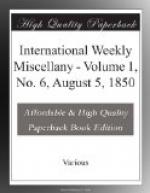Soon after the death of her father, she applied herself to teaching as a vocation, first in Boston, then in Providence, and afterward in Boston again, while her “Conversations” were for several seasons attended by classes of women, some of them married, and many of them of the most eminent positions in society. These conversations are described by Dr. Orestes A. Brownson, as “in the highest degree brilliant, instructive, and inspiring,” and our own recollections of them confirm to us the justice of the applause with which they are now referred to. She made her first appearance as an author, in a translation of Eckermann’s Conversations with Goethe, published in Boston in 1839. When Mr. Emerson, in the following year, established The Dial, she became one of the principal contributors to that remarkable periodical, in which she wrote many of the most striking papers on literature, art, and society. In the summer of 1843 she made a journey to the Sault St. Marie, and in the next spring published in Boston reminiscences of her tour, under the title of Summer on the Lakes. The Dial having been discontinued, she came to reside in New York, where she had charge of the literary department of the New York Tribune, which acquired a great accession of reputation from her critical essays. Here in 1845 she published Woman in the Nineteenth Century; and in 1846, Papers on Literature and Art, in two volumes, consisting of essays and reviews, reprinted, with one exception, from periodicals.
In the summer of 1845, she accompanied the family of a friend to Europe, visiting England, Scotland, and France, and passing through Italy to Rome, where they spent the ensuing winter. The next spring she proceeded with her friends to the north of Italy, and there stopped, spending most of the summer at Florence, and returning at the approach of winter to Rome, where she was soon after married to Giovanni, Marquis d’Ossoli, who made her acquaintance during her first winter in that city. They resided in the Roman States until the last summer, after the surrender of Rome to the French army, when they deemed it expedient to go to Florence, both having taken an active part in the Republican movement. They left Florence in June, and at Leghorn embarked in the ship Elizabeth for New York. The passage commenced auspiciously, but at Gibraltar the master of the ship died of smallpox, and they were detained at the quarantine there some time in consequence of this misfortune, but finally set sail again on the 8th of June, and arrived on our coast during the terrible storm of the 18th and 19th ult., when, in the midst of darkness, rain, and a terrific gale, the ship was hurled on the breakers of Fire Island, near Long Island, and in a few hours was broken in pieces. Margaret Fuller d’Ossoli, the Marquis d’Ossoli, and their son, two years of age, with an Italian girl, and Mr. Horace Sumner of Boston, besides several of the crew, lost their lives. We reprint a sketch of the works and genius of Margaret Fuller, written several years ago by the late Edgar A. Poe.




